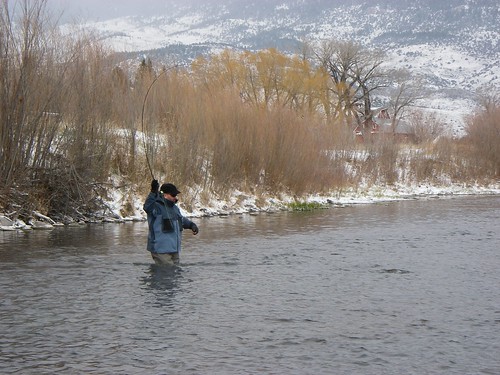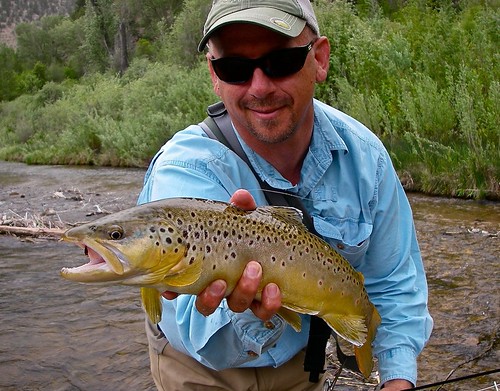Posted: 14 Dec 2011 01:33 PM PST
| 
|
| Trout will bite even on snowy, frigid days, if you know what fly patterns to throw. photo by Paul Schullery |
'Tis the season for winter fly-fishing. Here are seven tips to get you started, as well as my favorite fly patterns:
1. Pick the right place. Best winter rivers are Colorado tailwaters like the South Platte, Yampa, Frying Pan, or Gunnison; Montana tailwaters like the Bighorn and Madison; Wyoming rivers like the Snake River in Jackson; Idaho tailwaters like the South Fork and Henry’s Fork of the Snake; the Provo and Green in Utah, Great Lakes tributaries, and the upper Sacramento in California. As you can see, a fishing trip can often be combined with a ski trip.
2. Slow and deep is best. Use a strike indicator and weighted fly, or weight on the leader and the high-stick method, which keeps most of your fly line off the water. Dead drift is critical in winter because trout won’t chase a fly in cold water.
3. Swing with a sinking-tip line. Although dead-drift nymphing is best, if you prefer to swing a fly for trout or steelhead, use a sinking tip line with a very strong mend at the beginning of the cast so your fly swings slow and deep.
4. Look for rises. Occasionally trout will rise during the winter, almost always to small midges or olive mayflies. A small midge emerger or a tiny olive mayfly emerger will be the only dries you’ll need to carry.
5. Stay in bed in the morning. You’ll see the most surface activity mid-afternoon on sunny days, or, surprisingly, all day long on gray snowy days without wind.
6. Light tippets are usually more productive in winter. The flies are small and water is clear. I use 6X Mirage for trout fishing and 4X Mirage for steelhead under most conditions.
7. Know where the fish hold. Fish tend to “pod up” in winter in deeper, slower water. Once you catch one try not to disturb the water and continue to fish in the same place. Fish the slow water thoroughly, but move often if you aren’t connecting.
Best Flies for Winter Fishing
Nymphs:
English Pheasant Tail Nymph sizes 18 and 20. This version is far more effective than the bulkier American version for imitating the slim Blue-Winged-Olive mayflies and small brown stoneflies common in winter.
Disco Midge sizes 20 and 22. Imitates tiny midge pupae that hatch all winter long, particularly in western tailwaters. You can fish this one in the surface film for risers, but it's usually more effective deep, with Sink Putty on the leader (as are all of the nymphs listed here)
Flashback Scud size 16. In spring creeks and tailwaters that hold tiny freshwater crustaceans called scuds, this fly is essential.
Micro Stone size 14. Small stoneflies often hatch during the winter, so the nymphs are active in cold waters.
Vernille San Juan Worm . This fly in both red and tan imitates aquatic worms that get washed from the streambed when water rises slightly during dam releases on tailwaters.
Dries:
ICSI (I Can See It) Midge . Gray, size22. A floating midge pupa pattern you can spot on the water because of its orange parachute post.
Griffith's Gnat size 20. Great when adult midges skitter across the surface, especially when they form clumps.
Cannon's Bunny Dun , Baetis. Sizes 18 and 20. My favorite imitation out of many for winter Blue-Winged-Olive hatches.
Streamers:
Bead Head Flash Zonker . White, size 8. This fly has become one of the favorite streamers of the fly fishers on our staff. It's particularly effective in tailwaters, where light-colored shad and alewives get washed through turbines.
Moto's Minnow , Dark. Size 10. This small dark fly wiggles in even the slightest breath of current, important when you are fishing nearly dead-drift in winter. Its coloration is a perfect imitation of the sculpin, a small baitfish common in freestone streams.















 Drilling is likely to begin in the Delaware River Watershed - the source of drinking water for 15.6 million people - in a matter of weeks or months
Drilling is likely to begin in the Delaware River Watershed - the source of drinking water for 15.6 million people - in a matter of weeks or months 
 I'm writing to you today because as concerned residents of the Catskills, we cannot stand by and watch as our water, our air and our health are threatened. We cannot afford to take a backseat and watch as our vibrant lands and communities are turned into an industrialized fracking site. The price that each of us will pay is too great. We have only to look as far as our neighbors in Pennsylvania to see what a fracked future will look like for us.
I'm writing to you today because as concerned residents of the Catskills, we cannot stand by and watch as our water, our air and our health are threatened. We cannot afford to take a backseat and watch as our vibrant lands and communities are turned into an industrialized fracking site. The price that each of us will pay is too great. We have only to look as far as our neighbors in Pennsylvania to see what a fracked future will look like for us. 